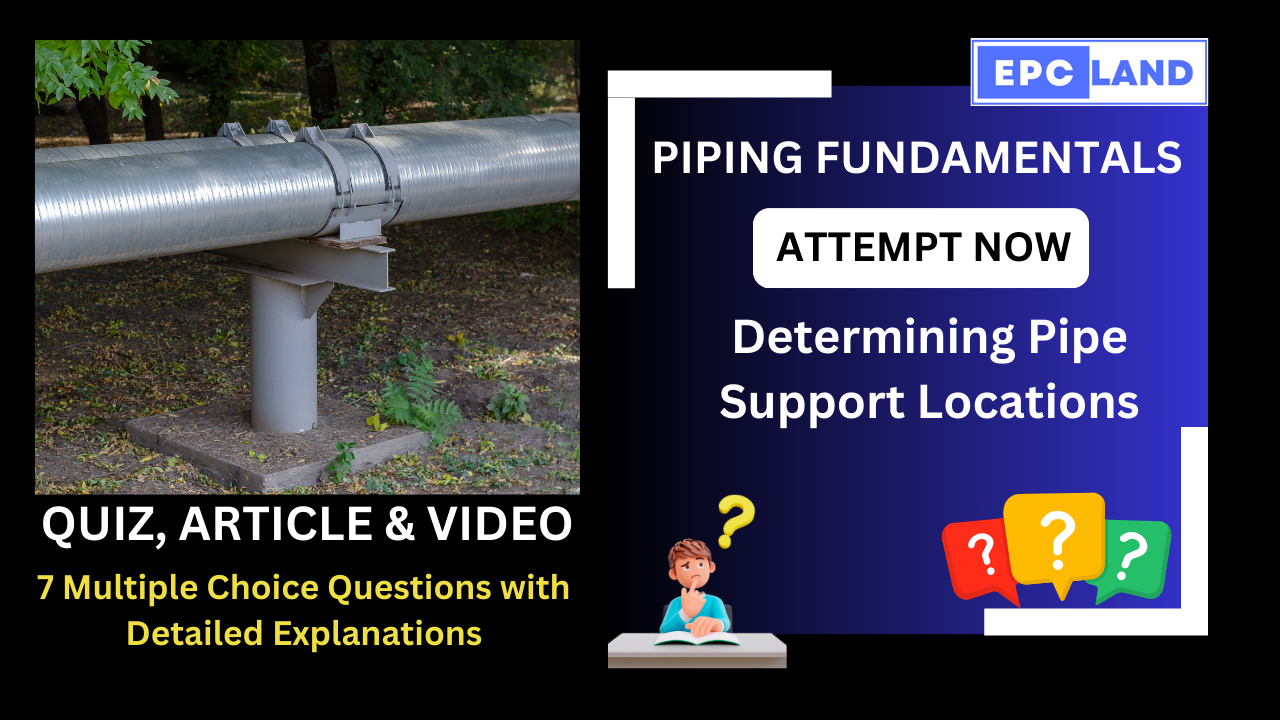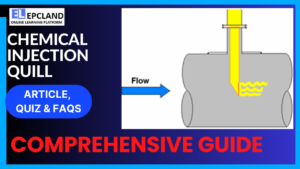1. Straight Sections while Determining Pipe Support Locations
While Determining Pipe Support Locations, why is it recommended to attach supports to straight sections of pipe rather than elbows, fittings, valves, flanges, or instruments?
Explanation: Attaching supports to straight sections reduces stress concentrations and promotes even load distribution, contributing to the stability of the piping system.
2. Expansion Loops while Determining Pipe Support Locations
Why is it recommended to consider the need for expansion loops near load-sensitive equipment, like pump suction lines?
Explanation: Expansion loops near load-sensitive equipment, like pump suction lines, help accommodate thermal expansion and contraction without affecting the sensitive equipment.
3. Friction Reduction in Determining Pipe Support Locations
When should friction-reducing slides between piping and support steel be evaluated?
Explanation: Friction-reducing slides should be evaluated, especially for high-temperature piping or lines with significant movement to reduce friction and avoid issues.
4. Maintenance Accessibility
How should piping be supported to allow spools to be removed for equipment maintenance without adding temporary supports?
Explanation: Piping should be supported in a way that allows spools to be removed for equipment maintenance without adding temporary supports, enhancing maintenance accessibility.
5. Spacing for Horizontal Runs
What is the recommended spacing for supports on horizontal runs, according to the rules of thumb?
Explanation: Supports on horizontal runs should be spaced no more than 10 pipe diameters apart to ensure proper support and stability.
6. Support near Changes in Direction
Why is it recommended to provide supports close to elbows and changes in direction?
Explanation: Supports should be provided close to elbows and changes in direction to counteract bending stresses and ensure stability in the piping system.
7. Utilizing Existing Structures
Why is it recommended to utilize existing beams, columns, and structural elements for support?
Explanation: Utilizing existing beams, columns, and structural elements for support saves material and simplifies installation, contributing to cost-effectiveness.
Don’t Miss 20+ Quizzes on Pipe Supports:
Short Article on Determining Pipe Support Locations
Key Considerations and Rules of Thumb
Choosing the right locations for pipe supports is crucial for the safe and efficient operation of piping systems. Many factors come into play, and neglecting any one can lead to problems down the line. Here are some key considerations and rules of thumb to keep in mind:
General Principles:
- Straight sections: Whenever possible, attach supports to straight sections of pipe, not elbows, fittings, valves, flanges, or instruments. This reduces stress concentrations and promotes even load distribution.
- Instrument proximity: Provide supports near instruments and other devices that might require frequent removal for maintenance. This facilitates access and avoids the need for temporary supports during maintenance activities.
- Expansion loops: Consider the need for adding expansion loops near load-sensitive equipment, like pump suction lines. This helps accommodate thermal expansion and contraction without affecting sensitive equipment.
- Friction reduction: Evaluate the need for friction-reducing slides between the piping and support steel. This can be especially important for high-temperature piping or lines with significant movement.
- Maintenance accessibility: Support the piping in a way that allows spools to be removed for equipment maintenance without adding temporary supports. This saves time and effort during maintenance procedures.
- Minimize spring hangers: Use spring hangers sparingly. While they offer flexibility, they can introduce unnecessary complexity and require regular monitoring and adjustments.
Additional Rules of Thumb:
- Spacing: For horizontal runs, space supports no more than 10 pipe diameters apart. For vertical runs, space them no more than 20 diameters apart.
- Changes in direction: Provide supports close to elbows and changes in direction to counteract bending stresses.
- Heavy components: Locate supports near heavy valves and fittings to minimize their contribution to overall load.
- Available structures: Utilize existing beams, columns, and structural elements for support whenever possible. This saves material and simplifies installation.
- Future needs: Consider potential future additions or modifications to the piping system when choosing support locations. Leave room for adding loops or changing support types if needed.
Remember, these are just general guidelines. Always consult relevant standards and codes like ASME B31.3, B31.1, and B31.8 for specific requirements and perform thorough flexibility analysis to ensure the chosen support locations meet the system’s operational and maintenance needs.
By following these principles and rules of thumb, you can make informed decisions about pipe support locations, contributing to the long-term reliability and maintainability of your piping system.
Table of Contents
Don’t miss the Course on Effective Isometrics Management: Check Now
Enrollment Link
Recommended courses (Published on EPCLand)
- Complete Course on Piping Engineering
- Basics of Piping Engineering
- Piping Layout Engineering
- Piping Material Engineering
- Piping Stress Analysis
- Material Requisitions
- Piping Material Specifications
- Valve Material Specifications
- Plant Design & Layouts-OISD 118
- Isometric Management
Library of Technical Articles
Don’t miss out the collection of 15+ articles on following topics:
- Basics of Oil and Gas Industry
- Valves
- Testing
- Tank
- Piping Bulk Items
- Pipe
- Metallurgy
- Piping Materials
- Layout
- Instrumentation
- Heat Exchanger
- Type of Contracts
- Codes and Standards
- ASTM Standards
- Articles on Piping Specialty Items
Video details of Complete Course on Piping Engineering
Why Enroll in the EPCLand
Proven Track Record– PTR
Activities & Achievements before launching EPCLand
- Published more than 50+ short courses
- 3000+ Enrolments
- More than 3,500,00 Minutes of watch hours in the last 2 years
- 4000+ Students in 100+ Countries
- Rating of 4+ out of 5
- 1000+ YouTube Videos
- 8K+ Subscribers
What Students will Learn
- Codes & Standards of the Energy Sector
- Piping Material Engineering
- Piping Layout Engineering
- Stress Analysis
Interesting facts
- All the published courses have been developed by Industry Experts with more than 2 decades of experience
- Content is based on Practical experience and real-time problems.
- Content is designed and organized in such a manner that it can be easily grabbed.
- Complete website, Blogs and Quiz sections are Planned, Designed and published by myself (About me: Atul Singla)
- Complete flexibility of Time & Location, Students can access the content from anywhere & anytime
- Moreover, once enrolled, the content can be access as many times as you want, which helps in understand the fundamentals in a better way.
Conclusion
In conclusion, our courses are meticulously crafted by industry experts with over two decades of hands-on experience. The content is rooted in practical knowledge, addressing real-time problems. The material is thoughtfully designed and organized for easy comprehension. Every aspect, from the website to blogs and quizzes, has been planned, designed, and executed by Atul Singla, ensuring a comprehensive and seamless learning experience. With the flexibility of accessing the content at any time and from any location, students have the freedom to learn on their terms. Furthermore, enrollment grants unlimited access, allowing learners to revisit the material as often as needed, fostering a deep understanding of the fundamentals.



